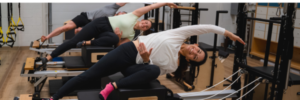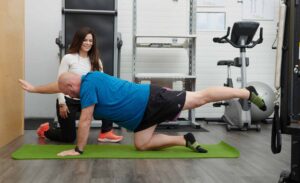Proper posture is when the natural or “neutral” curvature of your spine is maintained with minimal strain on your supporting musculature, tendons and ligaments. However, poor posture is something many people struggle with, especially due to the recent increase in those working from home. Having poor posture can affect many things including your musculoskeletal alignment, joint mobility, and even breathing. The term “postural kyphosis” can be used to describe postural misalignment in which the shoulders and head are rolled forward, creating a curve or “hump” in your upper back. It means the thoracic and cervical spine are in a position that no longer optimally absorbs shock or supports the head properly. This creates a lot of strain on the supporting musculature and ligaments of your spine, shoulders and neck causing discomfort. However, with time and persistence, postural kyphosis can be improved with a few simple solutions.

Stretch your Pectoralis (Chest) Muscles:
Poor posture can cause the pectoralis major and minor to become very tight. This is because they are always in a shortened state which holds onto that rolled forward shoulder position. Therefore, stretching your chest is the first step in loosening up your upper body to allow for your shoulders to move back into a more natural/comfortable position.
Try: Bent Arm Wall Stretch: Assuming a split stance (one foot in front of the other) keep your arm at 90 degrees, fingertips pointing upwards. Place your arm against a wall and step forward, you should feel the stretch in your pectoralis muscles. Hold for 30-45 seconds and repeat on both sides.
Strengthen your Trapezius:
Your trapezius is the large muscle that attaches at the base of your skull (occipital bone) and inserts at the spinous processes of your thoracic spine, clavicle and the spine of your scapula. Over time, your rounded shoulders stretch out your trapezius causing it to be weak, further allowing for poor posture. In strengthening your trapezius your neck, shoulders and spine can be pulled back into proper alignment.
Try: Shoulder Shrugs: Holding weight in both hands, and keeping them down at your sides, slowly shrug your shoulders up towards your ears. Pause for 5 seconds at the top, before slowly relaxing them back down. Repeat 3 times for a total of 10 repetitions.

Practice Proper Posture:
A few things we’ve all heard before “look straight ahead, keep your chin parallel with the floor and keep your shoulders down away from your ears”. While this may seem redundant, it can make all the difference. By consciously applying proper posture, you are going to train your body to feel comfortable again in proper alignment. At first it may feel a little uncomfortable, but the phrase “practice makes perfect” applies here!
Seek Proper Support for Your Feet:
We’ve said it before, and we’ll say it again! Having proper supportive footwear and/or orthotics, will ensure that your total body alignment is optimal for proper posture. By creating a proper base of support, you’re causing a chain reaction in all of your joints for optimal functioning. Come by and see a Pedorthist for your initial assessment.

For more information including exercises and stretches to help postural kyphosis and/or back pain book an appointment with one of our Kinesiologists today! We are here to help you move well, be well.




